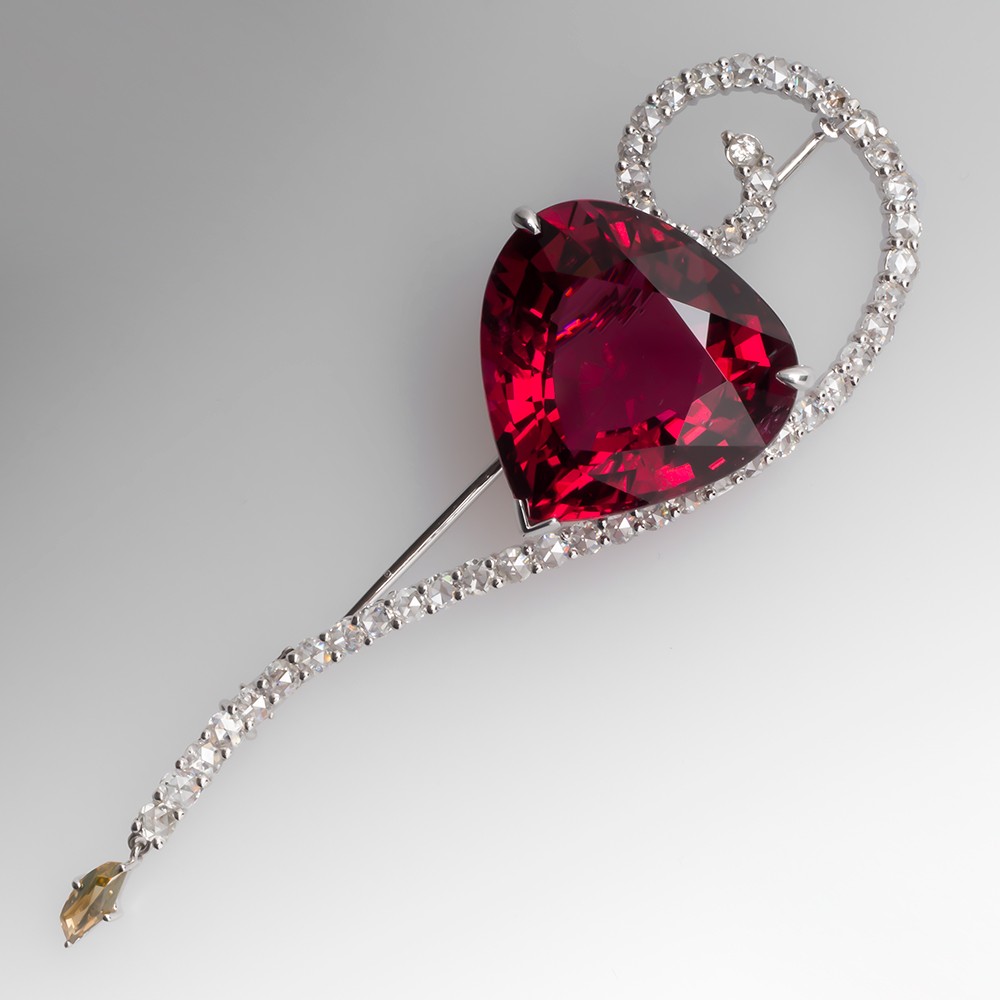Posted in: World Wedding Customs
 This rubellite & diamond brooch symbolizes the red cord that draws a couple together toward a Chinese Engagement and Wedding. Photo ©2018 EraGem Jewelry.
This rubellite & diamond brooch symbolizes the red cord that draws a couple together toward a Chinese Engagement and Wedding. Photo ©2018 EraGem Jewelry.
An Invisible Cord of Red
On the day she is born, the gods link a baby girl to her intended with a long red cord. This cord, invisible to the human eye, gradually shrinks. As time marches on, the soul mates on either end of this cord find themselves drawn inexorably together until they come face to face. This journey of the soul is unavoidable, unbreakable, and undeniable. The gift of the gods ensures that the man meant for her will find her. Of course, human nature compels families to actively participate in helping two lovers find each other. So, when a daughter comes of age, her parents hire a matchmaker.Matchmaker, Matchmaker
A matchmaker makes her living acting on behalf of the gods to ensure that Chinese sons and daughter find their soul mates. In a small village, the matchmaker might host a tea. She invites all the eligible Chinese youth, young men and young ladies. Like a European debutante ball, the matchmaker’s tea gives the young men and their families the opportunity to meet prospective brides. During the event, a young man carries with him a red embroidered bag. To show his interest in a young lady, he leaves his red bag on a saucer to indicate his choice. If the lady feels the tug of that invisible red cord, she takes the bag demonstrating that she accepts his offer. In larger villages and towns, matchmakers take a more individualized approach. A young man’s family hires a matchmaker to take a gift to the family of a young lady they choose for their son. The matchmaker acts as liaison, presenting the gifts and returning to the young man’s family with news of acceptance or rejection. If the family accepts his proposal, the matchmaker returns to his parents with the young woman’s birth hour, day, month, and year written on a slip of paper. The young man places this slip of paper on the family altar. It remains upon the altar for three days, during which time the family watches for inauspicious omens. Such bad omens might include quarrels erupting between the man’s parents, or loss of property. If the ancestors give their blessing, then the family hires an astrologer.Astrology & Auspicious Dates
An astrological match, determined using the Eight Characters, is essential for a happy marriage. The Eight Characters include the year, month, date, and hour of the young man's and young woman’s births. These characters place the two on the zodiac calendar, demonstrating their astrological compatibility. The young man’s family takes the four characters belonging to the young lady to their astrologer. If the astrologer deems the two a good match, then they deliver his four characters to her family. Her family seeks their own astrologer to determine if he is a good match for their daughter. Once compatibility is determined, one astrologer consults both their charts to determine the appropriate date for the official engagement and the dates for the delivery and exchange of various gifts.Betrothal Gifts Initiate Chinese Courtship
Following the guidance of the astrologer, the young man offers his betrothal gift to the young lady’s family on the first of the auspicious dates chosen. These gifts, often called Tea Presents, included tea (of course), bridal cakes, pairs of male and female chickens, wine, tobacco, sweetmeats, and sugar. The young lady’s family reciprocates with gifts of clothing and food. Several days following the exchange of the Tea Presents, the bride’s family sends the dowry to the groom’s family. While in the past the dowry included functional gifts like a chamber pot filled with fruit, today dowries includes a tea set, bedding, bathroom accessories, the bride’s clothing and jewelry, and possibly even small appliances and furniture. Upon completion of these gift exchanges, and armed with the readings from their astrologers, the families consult a Chinese almanac to choose a favorable date for the wedding. At this point, the couple is officially engaged. The next step involves sending out invitations to the ceremony and wedding feast. Traditionally, the couple delivered invitations and accompanying “double happiness cakes” in person. Modern couples typically dispense with this tradition, choosing instead to send invitations by mail.6 years ago
137 view(s) 